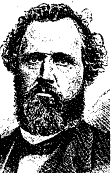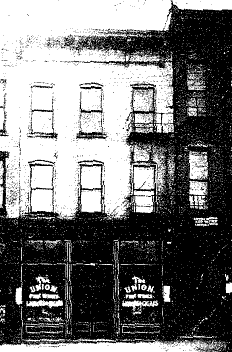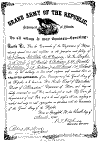|
AN
honor of which all Macon County is proud is that
Decatur is the birthplace of the Grand Army of
the Republic. That organization, started
with twelve members in Decatur, April 6, 1866,
and composed of men who had fought for the Union
during the War of the Rebellion, spread all over
the country. In its banner year, 1890, it
had a membership of 409,459, but every year its
ranks grow smaller and soon the last member will
be gone. It is one organization which
cannot recruit new members.
The idea of the Grand Army of
the Republic was conceived in the mind of Dr.
Benjamin F. Stephenson, surgeon of the
Fourteenth Illinois Infantry volunteers, later
appointed brigade surgeon and finally made
major. He was mustered out of service June
24, 1864, and located in Springfield where he
began the practice of medicine.

DR. B. F. STEPHENSON
Dr. Stephenson noticed
the neglect of widows and orphans of men who had
given up their lives during the war. That
neglect brought to his mind the idea of a
soldiers mutual benefit society, whose motto
should be, ""Loyalty, Fraternity and Charity".
The name was suggested to him by reading of
Napoleon's Grand Army of France.
Robert Mann Woods and Captain John S.
Phelps
assisted in getting the organization under way.
Captain Phelps knew of a printing office
in Decatur run by two soldiers, I. N. Coltrin
and Joseph Prior, and he came to them to
get the ritual printed. So much interest
was shown among the soldiers in Decatur that Dr.
Stephenson decided to organize the first
post here. In a dingy room on the second
floor of a building then standing at 253 South
Park street twelve men met Friday night, April
6, 1866, and instituted Post No. 1, Grand Army
of the Republic, founded on the principles of
charity, fraternity and loyalty.
It meant something to become a member of this
brotherhood of soldiers of the Union army for
the roll of membership was made a roll of honor.
Only soldiers who had been honorably discharged
from the army were permitted to join.
|

WHERE G. A. R. WAS
ORGANIZED |
|
The twelve members of
the original post were:
J. T. Bishop
J. W. Routh
John H. Nale
C. Riebsame
A. Toland
George H. Dunning
Col. Isaac C. Pugh
Joseph M. Prior
I. N. Coltrin
George R. Steele
Dr. B. F. Sibley
M. F. Kanan The first
officers were:
Commander - M. F. Kanan
Adjutant - George R. Steele
Quartermaster - G. H. Dunning
Officer of the day - C. Riebsame
Officer of the Guard - J. T. Bishop
Surgeon - J. W. Routh |
| |
Within two years the
membership of the post had reached eighty.
Meantime posts had been organized in other
cities. Springfield was the next to
organize after Decatur. Soon G. A. R.
posts were to be found all over the country.
Major Stephenson was the first
commander-in-chief. In 1868,
however, troubles arose, owing to political
dissentions, and every post in Illinois, with
the exception of Rockford, disbanded. For
ten years no meetings were held, except by the
Rockford post. Then reorganization began
on a non-partisan basis. Rockford post,
having remained in existence, became Post No. 1,
and the Decatur post, which was not reorganized
until in 1882, became Post 141. It was
named Dunham post after Amos Dunham,
who at that time was thought to have been the
first soldier from his county to give up his
life in the war. He was killed at Fort
Donelson, Feb. 15, 1862.1
In 1891 and older post No. 1 Society was
organized by members of the old post to
perpetuate the history of the organization.
Captain M. F. Kanan was the last of the
Decatur members of that society. He died
in 1909. His death left only one of the
charter members of the poor regional post, C.
Riebsame, of Bloomington. He, too, now
is gone.
the gray and the army to six presidents to the
United States. They were Ulysses S.
Grant, Rutherford B. Hayes, James a
Garfield, Chester A. Arthur, Benjamin
Harrison and William
McKinley.
The Decatur post has enrolled
more than 800 members during the years of its
existence. The majority of them have been
man who went into the war from other states then
Illinois. They were men who came to this
state, after the war was over, to make their
homes.

G. A. R. CHARTER
Then they were young and strong. Now they
are old. They are ranks are fast
dwindling. Less than 50 remain.
One of the honored and
members of the old post one, and afterwards of
the Dunham Post, was Comrade William of
Martin, who for years was the color bearer.
In every parade in which the soldiers took part
, Comrade Martin always was at the head,
carrying the flag. He participated and
state and national meetings, as well as local
processions. He served for some time as
the official color bearer for the Illinois
Department, G. A. R. Comrade Martin
presented the flag pole, with its concrete base,
in Central park, to the city.
The story of a Dunham post
would not be complete with out mention of Dr. W.
F. Calhoun, for years the mainstay
of the post, it's spokesman, and advisor, and
for fourteen years its commander. Elected
to that position in 1915 he remained in it until
his death in 1929. He was always looking
out for that interests of the post. He was
honored not only locally, but also by the state
G,A.R., and being elected department commander.
Dr. Calhoun's service in the war was in
the One Hundred Twenty-third Pennsylvania
regiment and Thirtieth of Pennsylvania cavalry.

DEDICATION OF G. A. R. CHARTER
TABLET
In Central park stands a monument to the Macon
county soldiers of the Civil war. It was
erected through the efforts of the Dorcas
society, which gave $2,000 toward the fund
necessary. The balance, $8,000, came from
Macon county, which gave $6,000, and citizens,
who subscribed $2,000. The monument was
unveiled and dedicated April 6, 1905, the
thirty-ninth anniversary of the founding of the
G. A. R. Another monument in
honor of the Union veterans stands on a grassy
knoll in Fairview park, the gift, in 1927, of
the Daughters of Union Veterans. Nearby is
the bronze tablet erected in 1926-27 by the
county in memory of the Civil war soldiers.
It contains the names of 2,085 men form Macon
county who fought in the war.
In Greenwood cemetery stands a monument, "To the
Unknown Dead", erected by the Woman's Relief
Corps. Various trees in the
county have been dedicated to the G. A. R. by
schools and other organizations.
To mark the birthplace of the G. A. R. the
Illinois department, Woman's Relief Corps,
placed a bronze tablet on the building in which
the first post was formed. That tablet was
unveiled and dedicated April 6, 1915.
Several members of Old Post 1 were guests of
honor on that occasion. Robert Mann
Woods, who had aided in the organization of
the Grand Army, gave an address, in which he
told of the early days of the Grand army.
The dedicatory address was given by Rt. Rev.
Samuel
Fallows, department commander of the G.
A. R.
The tablet was presented by Mrs. Inez J.
Bender, department W. R. C. president, and
it was unveiled by Ruth Donahue,
granddaughter of the first adjutant of the post,
George R. Steele.
The building in which the G. A. R. was organized
has been replaced with a new structure, the
Linxweiler building, on which the
memorial tablet is now fixed.
WOMAN'S RELIEF CORPS
Dunham Woman's Relief Corps No. 4, auxiliary to
Dunham Post 141, of the Grand Army of the
Republic, was instituted Dec. 10, 1883.
Its first regular meeting, early in 1884, took
place at the home of Mrs. S. T. Trowbridge,
whose husband had served as a surgeon through
the war.
The Decatur corps was one of the first
organized. The corps had been founded in
Denver, Colo., July 26, 1883. The first
five corps organized in Illinois formed a state
body Jan. 31, 1884, at a meeting held in
Decatur. The other four, besides Decatur,
in the state body were Rockford, Henry, Elgin
and Palestine. The Relief
corps has been, from its beginning, a real
auxiliary to the comrades. Patriotic work
among the schools and churches, charity work,
ministering to the comfort of the old soldiers,
and various other activities have kept the women
busy. Scores of flags unfurled to the
breeze by Macon county schools and other
institutions were the gifts of the Woman's
Relief corps. One of the
Decatur members, Mrs. Inez J. Bender, was
chosen in 1920 by the National Woman's Relief
Corps as its president.
-------------------
1.
Official war records show that at
least two other Macon county men died in war
service, previous to the time Dunham was
killed. Three members of the Dunham family
were in the army. Henry enlisted first,
and served three months, then returned, and then
the father, Dayton Dunham, and brother,
Amos, enlisted. Amos was short of stature
and was not accepted at first. To make
himself taller he inserted heels from a pair of
shoes in his boots. He was rejected again,
but finally was taken into Captain Lieb's
company. At the same time Amos Dunham
was being brought home dead, his father was
being brought back wounded, the father not
knowing of his son's fate until after he reached
home.
<PREVIOUS>
<NEXT>
<CLICK HERE TO
RETURN TO TABLE OF CONTENTS>
|